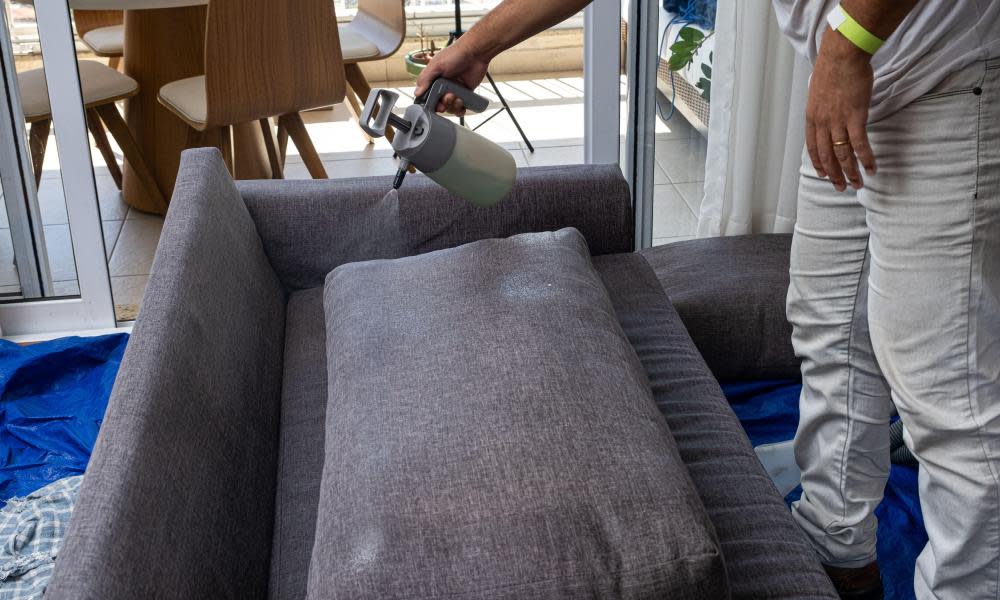Toxic PFAS not necessary to make fabric stain repellent, study finds

A new peer-reviewed study calls into question how well PFAS-based products repel water and stains in furniture, shoes, clothing, carpeting, outdoor gear and other consumer goods made of fabric.
Related: Trump appointees interfered to weaken EPA assessment of toxic chemical
Most water and stain repellents applied to fabrics worldwide use toxic PFAS as a main ingredient, and though the controversial chemicals are in thousands of products, water and stain repellency are two of their main consumer functions.
The study, which did not name brands, compared the performances of furniture fabric treated with PFAS to untreated fabric. It found the types of fabric, wear and how consumers manage stains to be much more important in determining how well fabrics repelled water and stains, and the study’s authors characterized PFAS as having “no practical benefit”.
“It was surprising to us that it was so clear, but the reason we did the study is because we had been talking with textile manufacturers who said PFAS don’t make much difference, but nobody had studied it scientifically,” said Carol Kwiatkowski, a co-author and senior science and policy associate with Green Science Policy Institute, the non-profit behind the study.
PFAS, or per- and polyfluoroalkyl substances, are a class of about 14,000 chemicals often used to make products resist water, stains and heat. They are called “forever chemicals” because they do not naturally break down, and are linked to cancer, liver problems, thyroid issues, birth defects, kidney disease, decreased immunity and other serious health problems.
PFAS on treated fabric can break off and end up in indoor air, attach to dust, or be dermally absorbed, and the pollution is especially a problem for homes with small children. The product is commonly applied to stain-resistant apparel and products for babies and children.
The repellants are also a major source of PFAS pollution in public spaces like airports or schools where carpeting is often heavily treated with the chemicals. Some products are treated with stain repellents during production, but dozens of brands also offer home sprays that expose consumers to the chemicals.
The study only checked furniture fabric and more research would need to be done to determine the chemicals’ effectiveness in clothing or fabrics for other uses, Kwiatkowski stressed. But she added “there’s no reason to think this would not be the case in other fabrics, as well”.
Each sample in the study was stained with water-based coffee and an oil-based salad dressing. The PFAS treatment’s effectiveness in repelling water greatly diminished with even moderate wear on the fabric sample, meaning consumers would have to keep applying PFAS to maintain reliability. The PFAS-treated samples showed no advantage when stained with water-based coffee, in part because coffee stains washed out so easily that PFAS are unnecessary.
Five of six PFAS-treated samples showed minor improvements in stain repellency when hit with the oil-based dressing, but only under ideal conditions – when the stains are set gently on the fabric and the stains are cleaned quickly. PFAS-treated fabric performed worse than unfinished samples under “non-ideal conditions”, the authors wrote.
“This means worn PFAS-finished fabrics must be maintained by frequent cleaning, similar to the need for cleaning unfinished fabrics,” the authors wrote.
Materials characteristics, like type of fabric, pattern, color, were much more important factors in how well a sample reduced a stain’s visibility. A cotton and nylon blend with the most sophisticated pattern and a polyester fabric with a two-color checkerboard pattern performed best. A polyester fabric with a simple pattern and even tone showed the stain the most.
The construction of the fabrics is also important. The more complex polyester fabric had a looser air-textured woven basket structure, coarse yarns, and rough surfaces can soak liquid where it remains trapped without being visible on the surface, the authors wrote.
The polyester that showed the stain more, meanwhile, had thinner fibers and a denser twill weave that kept staining liquids near the top of the fabric and more visible.
Ultimately, the findings show adding the toxic chemicals to furniture fabric is not necessary, the authors said.
“It makes you wonder what other uses of PFAS are also unnecessary and could be easily eliminated from products without noticeable change in performance,” said Jonas LaPier, a lead author on the study.
Asked to comment, the American Chemical Council trade group said it needed more time to review the study. Some producers of repellents have announced plans to phase out using PFAS, including 3M, manufacturer of Scotchgard, which has set a deadline in 2025 to stop making PFAS.
Products treated with PFAS ultimately end up in landfills where the chemicals can move into the environment and drinking water via leachate or groundwater. The EPA recently established low limits for some PFAS in drinking water, and no longer using the chemicals where they are not needed is essential to cleaning up widespread water pollution, Kwitakowski said.
“We should be stopping it on the front end,” she added. “We have to get to the point where we’re getting PFAS out of products, not just cleaning them up later.”

 Yahoo News
Yahoo News 
